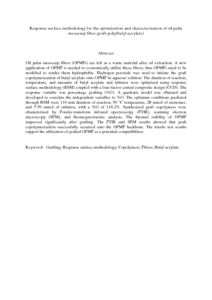Citation
Teh, Cher Chean and Ibrahim, Nor Azowa and Wan Yunus, Wan Md. Zin
(2013)
Response surface methodology for the optimization and characterization of oil palm mesocarp fiber-graft-poly(butyl acrylate).
BioResources, 8 (4).
art. no. http://www.ncsu.edu/bioresources/BioRes_08_4.html.
pp. 5244-5260.
ISSN 1930-2126
Abstract
Oil palm mesocarp fibers (OPMFs) are left as a waste material after oil extraction. A new application of OPMF is needed to economically utilize these fibers; thus OPMFs need to be modified to render them hydrophobic. Hydrogen peroxide was used to initiate the graft copolymerization of butyl acrylate onto OPMF in aqueous solution. The duration of reaction, temperature, and amounts of butyl acrylate and initiator were optimized using response surface methodology (RSM) coupled with a four-factor central composite design (CCD). The response variable was percentage grafting (%G). A quadratic model was obtained and developed to correlate the independent variables to %G. The optimum conditions predicted through RSM were 110 min duration of reaction, 50 °C temperature, 28 mmol of monomer, and 5.99 mmol of initiator, with a %G of 116.2%. Synthesized graft copolymers were characterized by Fourier-transform infrared spectroscopy (FTIR), scanning electron microscopy (SEM), and thermogravimetric analysis. The thermal stability of OPMF improved significantly after grafting. The FTIR and SEM results showed that graft copolymerization successfully occurred onto the OPMF backbone. The tensile test results support the utilization of grafted OPMF as a potential compatibilizer.
Download File
![[img]](http://psasir.upm.edu.my/30118/1.hassmallThumbnailVersion/Response%20surface%20methodology%20for%20the%20optimization%20and%20characterization%20of%20oil%20palm%20mesocarp%20fiber.pdf)  Preview |
|
PDF (Abstract)
Response surface methodology for the optimization and characterization of oil palm mesocarp fiber.pdf
Download (84kB)
| Preview
|
|
Additional Metadata
Actions (login required)
 |
View Item |

